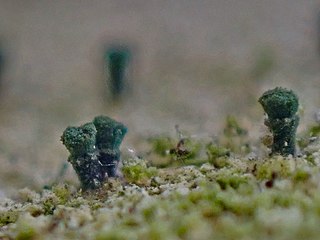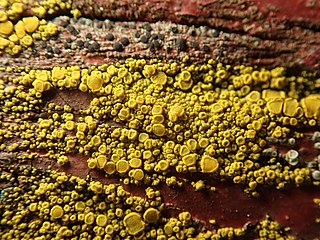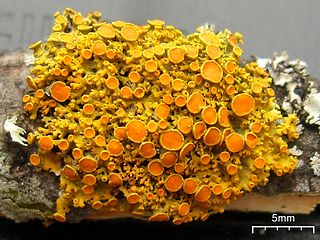Biatorellaceae is a family of lichen-forming fungi in the subclass Lecanoromycetidae. The family is monotypic, and contains the single genus Biatorella, which contains eight species.

The Teloschistaceae are a large family of mostly lichen-forming fungi belonging to the class Lecanoromycetes in the division Ascomycota. Many members of the Teloschistaceae are readily identifiable by their vibrant orange to yellow hue, a result of its frequent anthraquinone content. The presence of these anthraquinone pigments, which confer protection from ultraviolet light, enabled this group to expand from shaded forest habitats to harsher environmental conditions of sunny and arid ecosystems during the Late Cretaceous. Collectively, the family has a cosmopolitan distribution, although members occur predominantly in subtropical and temperate regions. Although most members either live on rock or on bark, about 40 species are lichenicolous–meaning they live on other lichens.

The Physciaceae are a family of mostly lichen-forming fungi belonging to the class Lecanoromycetes in the division Ascomycota. A 2016 estimate placed 19 genera and 601 species in the family.

The Baeomycetales are an order of mostly lichen-forming fungi in the subclass Ostropomycetidae, in the class Lecanoromycetes. It contains 8 families, 33 genera and about 170 species. As a result of molecular phylogenetics research published in the late 2010s, several orders were folded into the Baeomycetales, resulting in a substantial increase in the number of taxa.

The Gomphillaceae are a family of lichen-forming fungi in the order Graphidales. Species in this family are found mostly in tropical regions.

Microcalicium is a genus of lichen-forming fungi in the order Pertusariales. It is the only genus in the monotypic family Microcaliciaceae. These taxa were circumscribed by the Finnish lichenologist Edvard August Vainio in 1927, with Microcalicium disseminatum assigned as the type species.

Candelariella is a genus of bright yellow, ocher, or greenish yellow crustose or squamulose lichens in the family Candelariaceae. Members of the genus are commonly called eggyolk lichens, goldspeck lichens, or yolk lichens. The genus was circumscribed in 1894 by Swiss lichenologist Johannes Müller Argoviensis, with Candelariella vitellina assigned as the type species.

Placomaronea is a genus of lichenized fungi in the family Candelariaceae. It has 6 species. The genus was circumscribed by Finnish lichenologist Veli Räsänen in 1944, with Placomaronea candelarioides assigned as the type species. The genus was revised by Martin Westberg and colleagues in 2009, who accepted six species in the genus.
Menegazzia megalospora is a species of foliose lichen from South America. It was formally described as a new species in 1942 by Finnish lichenologist Veli Räsänen, as a member of Parmelia. Rolf Santesson transferred it to the genus Menegazzia in 1942.
Menegazzia wilsonii is a species of lichen found in South America. It was first described to science as Anzia wilsonii by Veli Johannes Paavo Bartholomeus Räsänen in 1944, transferred to the genus Pannoparmelia in 1978, and finally transferred to Menegazzia in 2005.
Candelariella vainioana is a species of crustose lichen in the family Candelariaceae. It was described by Finnish lichenologist Rainar Hakulinen in 1954 from collections made by Edvard August Vainio in Hollola in 1874. The specific epithet vainioana honours Vainio. The lichen has been reported from Finland, Sweden, and Norway. The lichen's common name in Swedish is kopparägglav, and kuparikeltuaisjäkälä in Finnish, both of which mean "copper egg-yolk". As of 2019, it is considered to be an endangered species in Finland due to its small population.
Rainar Alarik Hakulinen was a Finnish lichenologist and schoolteacher. He was noted as an expert on the lichen family Candelariaceae, and was known for his numerous phytogeographical publications about the boreal and arctic lichens of Finland, Northern Norway, and Russian Karelia.

Catillaria is a genus of crustose lichens in the family Catillariaceae. The genus was circumscribed by Italian lichenologist Abramo Bartolommeo Massalongo in 1852. It is the type genus of Catillariaceae, which was circumscribed by Austrian lichenologist Josef Hafellner in 1984.

Carbonicola is a small genus of lichen-forming fungi. It is the sole genus in the monogeneric family Carbonicolaceae. The genus, which collectively has an almost cosmopolitan distribution, contains three squamulose lichens that prefer to grow on burned wood in temperate areas of the world.

Gallowayella hasseana, the poplar sunburst lichen, is a species of corticolous (bark-dwelling), crustose lichen in the family Teloschistaceae. It occurs in North America.
Candelinella is a genus of lichen-forming fungi in the family Candelariaceae. It contains two species of crustose lichens. It is visually similar to the genus Candelina but has unique features, including a distinct thallus and unique spore structures. It was established by Sergey Kondratyuk in 2020, with Candelinella makarevichiae assigned as the type species. The genus is distinguished by the small, crustose thallus that ranges from a granular to areolate or squamulose texture, and the simple to 1-septate, narrowly ellipsoid to oblong ascospores. Its lack of a lower cortex and medulla further sets it apart from Candelina.
Opeltiella is a genus of lichen-forming fungi in the family Candelariaceae. The genus, established by Sergey Kondratyuk in 2020, has four species. It is differentiated from the similar genus Candelaria by its unique features such as eight-spored asci and absence of a lower cortical layer and true rhizines. The genus is characterised by its areolate to more or less squamulose or foliose thallus and the unique chemical substances it contains, such as calycin, pulvinic and vulpinic acids, and pulvinic acid lactone.
Protothelenella is a genus of fungi in the family Protothelenellaceae. It contains 11 species, some of which form lichens. Protothelenella species have a crustose thallus with spherical to pear-shaped, dark brown to blackish perithecia. Microscopic characteristics of the genus include bitunicate asci with an amyloid tholus, and ascospores that are colourless and contain multiple internal partitions. Some species grow on acidic substrates including rocks, soil, bryophytes, plant detritus or rotten wood. Other species are lichenicolous (lichen-dwelling), growing on species of Solorina, Peltigera, Pseudocyphellaria, or Cladonia.

Placomaronea candelarioides is a species of saxicolous (rock-dwelling), foliose lichen in the family Candelariaceae. It is found in South America. This lichen species can be recognised by its distinct umbilicate, monophyllous growth form.
Placomaronea lambii is a species of saxicolous (rock-dwelling) lichen in the family Candelariaceae. It occurs at high altitudes in Argentina, Ecuador, and Peru, where it grows on acidic rocks in open habitats.










